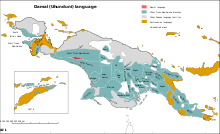Amung language
Uhunduni, also known as Damal and Amung (Amung Kal) after two of its dialects, is the language of the Amung people. It is a Trans–New Guinea language that forms an independent branch of that family in the classification of Malcolm Ross (2005). However, it is treated as an isolate by Palmer (2018).[3]
| Uhunduni | |
|---|---|
| Damal | |
| Amung | |
| Region | Papua: central highlands, Paniai Regency, Beoga and Ilaga sub-districts; Asmat, Deiya, Mimika, and Puncak regencies, north and south Carstens Mountains; possibly Lanny Jaya and Nduga regencies. |
| Ethnicity | Amung people |
Native speakers | 14,000 (2000)[1] |
Trans–New Guinea
| |
| Language codes | |
| ISO 639-3 | uhn |
| Glottolog | dama1272[2] |
 Map: The Amung language of New Guinea
The Amung language
Other Trans–New Guinea languages
Other Papuan languages
Austronesian languages
Uninhabited | |
Dialects are Amongme, Amung, Damal, Enggipilu.
Classification
Pawley and Hammarström (2018) do not consider there to be sufficient evidence for Uhunduni to be classified as part of Trans-New Guinea, though they do note the following lexical resemblances between Uhunduni and proto-Trans-New Guinea.[4]
- no- ‘eat’ < *na-
- mo- come’ < *me-
- mini- ‘sit’ < *mVna-
- eme- ‘give’ < *mV-
Pronouns
Ross (2005) lists the pronouns as:
sg du pl 1 na iru enoŋ 2 a erop 3 na nuŋ
Iru is an inclusive dual.
gollark: What if I just go for the structure of `CREATE TABLE things (entity TEXT, attribute TEXT, value TEXT)` to make it extensible?
gollark: So I should use *two* sqlite databases?
gollark: Well, if you like sqlite, I suppose I will switch back.
gollark: Yep!
gollark: I decided to use postgres instead of sqlite.
References
- Uhunduni at Ethnologue (18th ed., 2015)
- Hammarström, Harald; Forkel, Robert; Haspelmath, Martin, eds. (2017). "Damal". Glottolog 3.0. Jena, Germany: Max Planck Institute for the Science of Human History.
- Palmer, Bill (2018). "Language families of the New Guinea Area". In Palmer, Bill (ed.). The Languages and Linguistics of the New Guinea Area: A Comprehensive Guide. The World of Linguistics. 4. Berlin: De Gruyter Mouton. pp. 1–20. ISBN 978-3-11-028642-7.
- Pawley, Andrew; Hammarström, Harald (2018). "The Trans New Guinea family". In Palmer, Bill (ed.). The Languages and Linguistics of the New Guinea Area: A Comprehensive Guide. The World of Linguistics. 4. Berlin: De Gruyter Mouton. pp. 21–196. ISBN 978-3-11-028642-7.
- Ross, Malcolm (2005). "Pronouns as a preliminary diagnostic for grouping Papuan languages". In Andrew Pawley; Robert Attenborough; Robin Hide; Jack Golson (eds.). Papuan pasts: cultural, linguistic and biological histories of Papuan-speaking peoples. Canberra: Pacific Linguistics. pp. 15–66. ISBN 0858835622. OCLC 67292782.
This article is issued from Wikipedia. The text is licensed under Creative Commons - Attribution - Sharealike. Additional terms may apply for the media files.